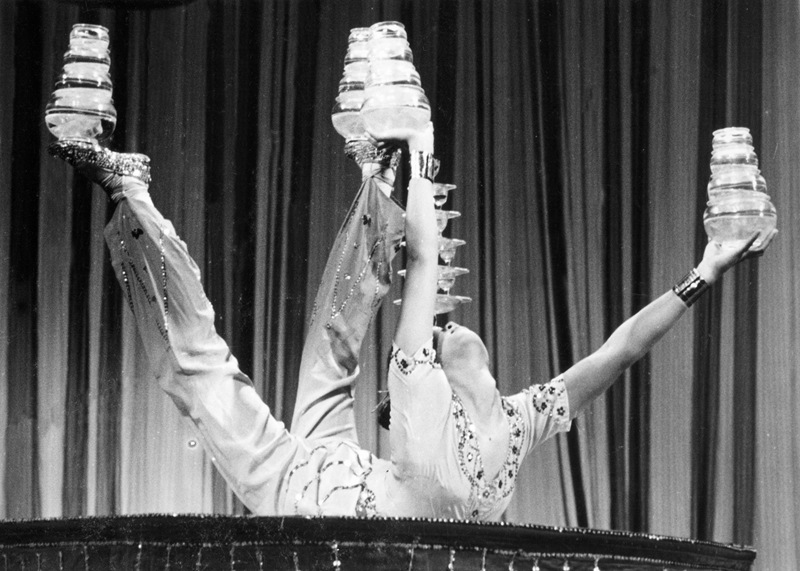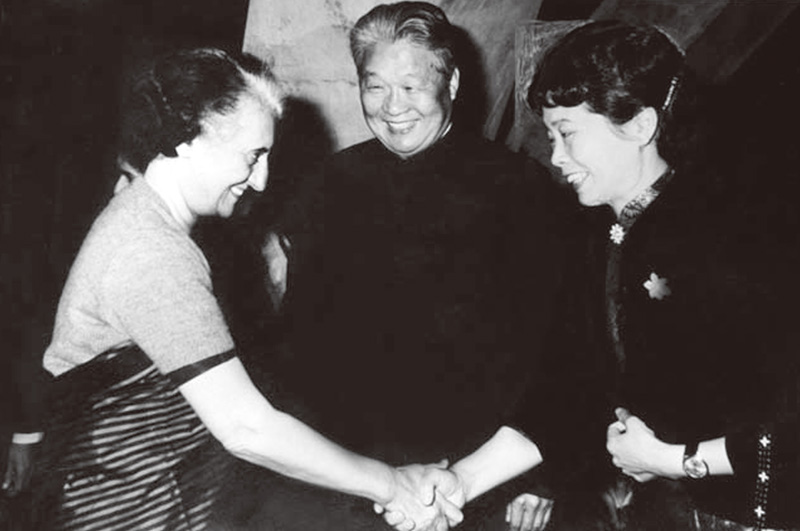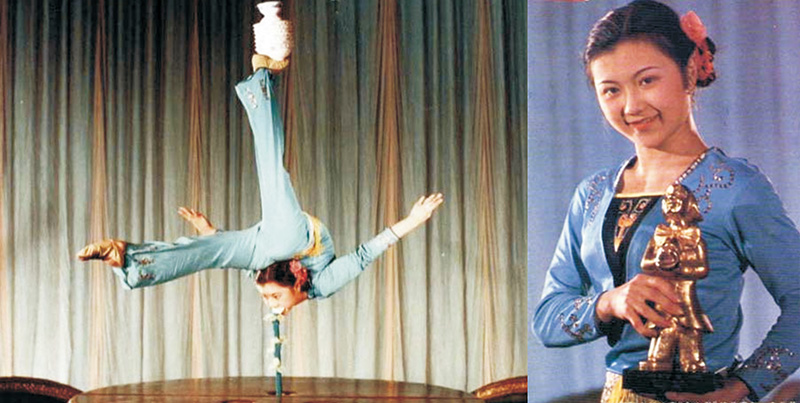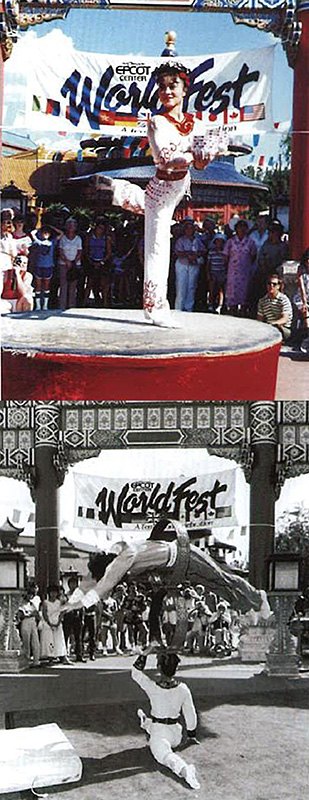
The Statistics on China’s performing products go abroad by China Performing Arts Group.
Cultural trade is an important domain of cultural exchange, while international commercial show constitutes a key part of cultural trade. In the wake of adoption of reform and opening up, HU Yaobang, then China’s leader, attached such great importance to international commercial show that he made comments on documents on three occasions. The third occurred in 1986 when he read a report about the successful commercial show of Dalian Acrobatic Troupe in the Netherlands. His comments go as follows: “Such overseas commercial shows have given publicity to China, promoted friendship, and brought back considerable income to improve circus artists’ life. We have not a single reason to give it up. Instead, we have 100 reasons to take it into our consideration”.

In 1956 SUN Tai a ventriloquist from Shanghai Acrobatic Troupe and one of the first vice presidents of China Acrobats Association won the Gold Medal at the 1st Warsaw International Acrobatic Festival in Poland.
Reform and opening up brought the overseas commercial show by China’s circus into a promising future, and thus the related channels, frequency and the number of performers reached an unprecedented record. From 1978 till 2012, China’s circus troupes toured more than 100 countries and regions on five continents, and some troupes became a regular participant in the circus festivals of major countries in Europe and America on a long-term basis. Some world-renowned circuses, such as Cirque du Soleil, also have Chinese acrobats. The foreign exchange earned by China’s circus art troupes accounts for over 80% of the total by all forms of performing arts, with invariable top rank in this
regard. For instance, Swan Lake, a creative circus act, has reached a turnover of 43 million RMB from overseas performance.


Exploring New Ways and Embarking on a New Journey
At the 3rd Plenary Session of the 11th CPC Central Committee in 1978, China adopted the policy of reform and opening up, which is considered to be a profound revolution to transform China in a way to influence the world. It has pioneered the socialist development path with Chinese characteristics, changed Chinese people’s life styles and mindsets, and reshaped China’s national image and international status. It is a great epic of the Chinese nation dedicated to human progress in civilization as well as China’s most wonderful story in modern times. Thanks to the reform and opening up, China’s cultural exchanges have entered a prosper phase of development.

In 1983 LI Liping the 4th generation heir of Balancing Bowls Act won the Golden Clown Award at the 9th International Circus Festival of Monte Carlo as the first China’s winner of this award

In 1984 Foot-juggling of Bench Act by Shandong Acrobatic Troupe won the Golden Clown Award at the 10th International Circus Festival of Monte Carlo.

In 1985 Hangzhou Acrobatic Troupe went to Disney World in Florida for a 6 months commercial show.
Along with the increasing standardization and institutionalization of cultural exchange, China constantly expanded the scope of exchange from those countries of traditional friendship to the Western countries such as U.S. and neighboring countries, with the frequency of exchange multiplied as well. Within a decade, China’s cultural exchanges rose rapidly from 194 events and 3,035 people in 1979 to 1,075 events and 9,499 people in 1986. From 1978 till 2012, four major areas of cultural exchanges were initially established, namely cultural diplomacy, cultural international publicity, cultural exchange and cultural trade. Meanwhile, an all-round, multi-level, wide-ranging and multi-channel pattern took shape, and non-governmental exchanges were more than thriving. China’s circus, in particular, with its unique artistic characteristics and industrial advantages, has made outstanding achievements in earning foreign exchange through overseas commercial performances and winning awards in international competitions.

In 1986 Shanghai Acrobatic Troupe visited Japan for a 136-day commercial tour
Serving China’s Diplomacy and Building up a Good National Image of China
Arts and culture are crucial for a nation’s prosperity. They have their root in real life and are passed down from generation to generation. With diverse manifestations, they depict people’s life and reflect people’s true feelings, and thus become the most effective and efficient medium for communications among all the ethnic groups. Culture and art can touch people’s hearts, arouse sympathy, bring people closer beyond prejudice and past grudge, and enable them to reach consensus. In recent years, though peace and development remain as the themes of the times, the world is still experiencing fierce competition, complicated international relationship and unpredictable momentum. In this context, cultural exchanges are essential to enhance friendship between peoples, bridge differences and eliminate misunderstandings, and promote the sound bilateral relations, which was mostly agreed in this era. With great importance attached to cultural exchange.

In 1993 Jinan Acrobatic Troupe visited Fiji Vanuatu Kiribati Marshall Islands and Micronesia

In 1994 Head Balancing Act by Hebei Acrobatic Troupe won the Prize of the President of the Republic of France at the 17th Festival Mondial du Cirque de Demain in France.
and update mindset with the time, China’s leaders raised new and higher requirements for cultural exchanges in accordance with the latest development and change at home and abroad. Culture, along with politics and economy, becomes one of the three pillars of China’s overall diplomacy.
Circus, as one of the most vivid performing arts in life, has natural advantages in cultural exchanges. It has showed crucial role by serving China’s all-round diplomacy, showcasing the achievements of Chinese cultural construction to the world, and improving the soft power and international influence of Chinese culture.

In 1996 Beijing Acrobatic Troupe participated in the Cirque du Soleil gala show in Canada and then toured in UK
Winning International Awards Indicates World-leading Strength of Circus
Blessed with a profound cultural tradition and a time-honored history, China’s circus art features a distinct and unique artistic style in a prominent place in the international community. China’s circus has made its mark in the international arena as early as in 1956. SUN Tai, a ventriloquist from Shanghai Acrobatic Troupe and one of the first vice presidents of CAA, won the Gold Medal at the 1st Warsaw International Acrobatic Festival. During the 6th World Festival of Youth and Students held in USSR in 1957, China won 27 gold medals, including XIA Juhua’s Head-balancing Bowls, Unicycle by JIN Yeqin and his sister, and Spin Plate by QIAO Pinghai. In the following 30 years, China’s circus competed for the gold and silver medals in over 20 professional international circus festivals held in over 10 countries such as Monaco, France, UK, Russia, DPRK, Italy, Sweden, Spain, Hungary, Belgium, Cuba and U.S. Numerous trophies, medals and honors won by China’s artists demonstrate China’s strength of circus in the international arena.

In 1997 Plates Spinning Act by Nanjing Acrobatic Troupe won the Silver Medal at the 3rd “Princess” International Acrobatic Festival of Stockholm in Sweden.

In 2012 Teeterboard and Living Statues by Shanghai Acrobatic Troupe jointly won the Golden Clown Award at the 36th International Circus Festival of Monte Carlo

